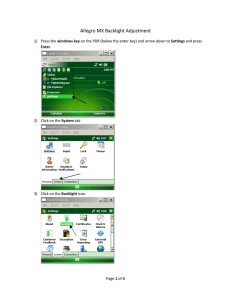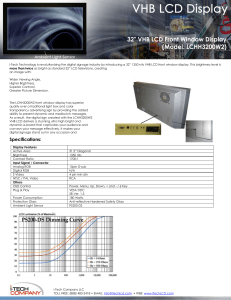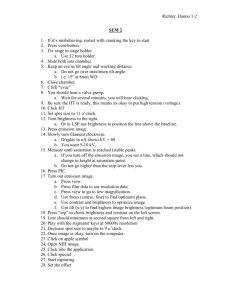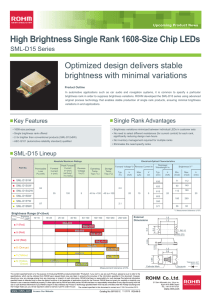Understanding LCD Monitors: Brightness and Contrast
advertisement
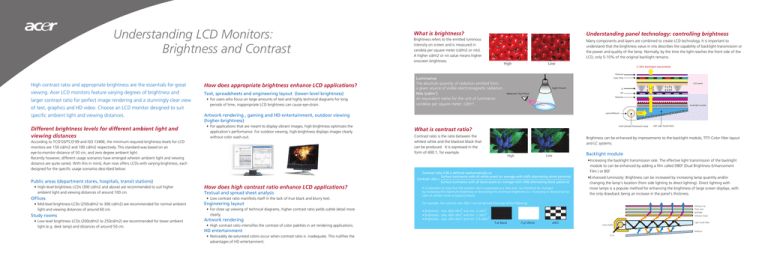
Understanding LCD Monitors: Brightness and Contrast What is brightness? Understanding panel technology: controlling brightness Brightness refers to the emitted luminous intensity on screen and is measured in candela per square meter (cd/m2 or nits). A higher cd/m2 or nit value means higher onscreen brightness. Many components and layers are combined to create LCD technology. It is important to understand that the brightness value in nits describes the capability of backlight transmission or the power and quality of the lamp. Normally, by the time the light reaches the front side of the LCD, only 5-10% of the original backlight remains. High Low 5-10% backlight transmitted Polarizer High contrast ratio and appropriate brightness are the essentials for great How does appropriate brightness enhance LCD applications? viewing. Acer LCD monitors feature varying degrees of brightness and Text, spreadsheets and engineering layout (lower-level brightness) larger contrast ratio for perfect image rendering and a stunningly clear view of text, graphics and HD video. Choose an LCD monitor designed to suit specific ambient light and viewing distances. Different brightness levels for different ambient light and viewing distances • For users who focus on large amounts of text and highly technical diagrams for long periods of time, inappropriate LCD brightness can cause eye-strain. • High-level brightness LCDs (300 cd/m2 and above) are recommended to suit higher ambient light and viewing distances of around 100 cm. Offices • Mid-level brightness LCDs (250cd/m2 to 300 cd/m2) are recommended for normal ambient light and viewing distances of around 60 cm. Study rooms • Low-level brightness LCDs (200cd/m2 to 250cd/m2) are recommended for lower ambient light (e.g. desk lamp) and distances of around 50 cm. Color filter LCD panel Light Source • For applications that are meant to display vibrant images, high-brightness optimizes the application's performance. For outdoor viewing, high-brightness displays images clearly without color wash-out. TFT Polarizer backlight module Lamp Reflector Contrast ratio is the ratio between the whitest white and the blackest black that can be produced. It is expressed in the form of 400:1, for example. Textual and spread sheet analysis • Low contrast ratio manifests itself in the lack of true black and blurry text. Engineering layout • For close up viewing of technical diagrams, higher contrast ratio yields subtle detail more clearly. Low High Artwork rendering • High contrast ratio intensifies the contrast of color palettes in art rendering applications. Surface luminance with all black pixels (or average with ANSI alternating black patterns) It is important to note that the contrast ratio is expressed as a ratio and can therefore be changed by increasing the maximum brightness or decreasing the minimum brightness (i.e. increasing or decreasing the ratio of whitest white to blackest black). Backlight module • Increasing the backlight transmission rate: The effective light transmission of the backlight module to can be enhanced by adding a film called DBEF (Dual Brightness Enhancement Film ) or BEF. •Enhanced luminosity: Brightness can be increased by increasing lamp quantity and/or changing the lamp's location (from side lighting to direct lighting). Direct lighting with more lamps is a popular method for enhancing the brightness of large screen displays, with the only drawback being an increase in the panel's thickness. For example, the contrast ratio 400:1 can be derived from any of the following: • Brightness: max. 800 cd/m2 and min. 2 cd/m2 • Brightness: max. 400 cd/m2 and min. 1 cd/m2 • Brightness: max. 200 cd/m2 and min. 0.5 cd/m2 Diffusion Up Prism Lens BEF/DBEF Diffusion Down Full Black Full White ANSI Lamp Holder HD entertainment • Noticeably de-saturated colors occur when contrast ratio is inadequate. This nullifies the advantages of HD entertainment. LGP: Light Guide Plate Brightness can be enhanced by improvements to the backlight module, TFT/ Color filter layout and LC systems. Contrast ratio (CR) is defined mathematically as: Surface luminance with all white pixels (or average with ANSI alternating white patterns) How does high contrast ratio enhance LCD applications? 100% Cold Cathode Fluorescent Lamp What is contrast ratio? Contrast ratio = 50% LC Observer’s Eye Point Artwork rendering , gaming and HD entertainment, outdoor viewing (higher-brightness) According to TCO’03/TCO’99 and ISO 13406, the minimum required brightness levels for LCD monitors are 150 cd/m2 and 100 cd/m2 respectively. This standard was based on an eye-to-monitor distance of 50 cm, and zero degree ambient light. Recently however, different usage scenarios have emerged wherein ambient light and viewing distance are quite varied. With this in mind, Acer now offers LCDs with varying brightness, each designed for the specific usage scenarios described below: Public areas (department stores, hospitals, transit stations) Luminance The absolute quantity of radiation emitted from a given source of visible electromagnetic radiation. Nits (cd/m2) An equivalent name for the unit of luminance: candelas per square meter, cd/m2. Light Guide Plate Reflector CCFL Understanding panel technology:contrast ratio improvements TFT/ Color filter BM layout • By enlarging the effective area of the TFT layout and decreasing the width of the color filter BM (Black Matrix), the total aperture ratio is increased and brightness is enhanced. Maximum brightness (whitest white) level: As mentioned above, brightness can be improved via improvement to the backlight module, TFT/Color Filter BM and LC systems. TFT Pixel Minimum brightness (blackest black) level: B/M Effective Area The process of dynamic contrast ratio is as follows: Acer CrystalBrite™ technology includes an anti-reflection coating that enhances the contrast ratio and sharpens images. With this anti-reflection coating, ambient light is absorbed, reducing its effect on the blackest black. 1st: Measure the input image gray level histogram to get the Mode value. Acer CrystalBrite LCD The actual blackness of the blackest black is critical to the contrast ratio. Even a small adjustment to the denominator will cause a huge enhancement to contrast ratio while similarly small adjustments to the numerator will have little effect. Adjustments to the denominator can be made via Color Filter (CF) material, different LC driving systems and anti-reflection coating. Color Filter Pixel Acer CrystalBrite™ technology (Anti-reflection coating) White level AR Coating 36% improved contrast Black level Effective Area 40% Capacltor 100% LC driving system The different LC driving systems such as TN (Twisted Nematic), VA (Vertical Alignment) and IPS (In Plate Switching) are also important factors for enhancing brightness. Some LC driving system principles improve the contrast ratio's denominator value by pre-tilting the light alignment, which in turn controls light leakage from the front-right side. Less light leakage improves the contrast ratio by maintaining a blacker black. 2nd: Adjust the backlight to proper luminance range according to Mode value. If the most frequently occurring counts are distributed in the darker area, then the backlight will be modulated to a lower level and power will be conserved. LCDs with directing backlight can achieve the partial control to reach higher contrast ration. LCDs with LED backlight are easier to divide into more subsections with independent brightness control and reach much superior dynamic contrast ratio compared to LCDs with CCFL backlight. 3rd: Adjust the Gamma curve slightly according to Mode value. If the most frequently occurring counts are distributed in the darker area, then the slope will be higher at the darker gray level and reflect more dark details on the dimming image. Normal Glared LCD White level Input Images Step 1st Step 2nd Step 3rd Histogram of input image Backlight Brightness Modulation Gamma Curve Correction Luminance Output Output Images Black level Count Improvements to the Color Filter (CF), polarizer and PI alignment layer material Acer CrystalBrite™ technology (Glare-coating) • Conventional LCDs diffuse internal lamp light that will reduce brightness. Acer CrystalBrite™ technology features a glare-coating that reduces light diffusion without dimming brightness so that images are displayed with clear, clean edges and vibrant color. TN Off(White) IPS On(Black) Off(Black) A truer black can be achieved by using color-resistant materials in the Color Filter. This prevents light leakage in the dark state. Improvements can also be made to other materials such as the polarizer and PI alignment layer. VA On(White) Off(Black) Input Grey level Power Output Luminance Count On(White) Understanding panel technology: contrast ratio improvements Acer CrystalBrite LCD Higher brightness AR coating Hard Coating 33% improved brightness Lamp Normal Non-Glared LCD Normal brightness Lamp Dynamic contrast ratio Grey level Input Power For panels that support backlight modulator parameters and Gamma correction adjustment, dynamic contrast ratio is used to measure contrast ratio improvements. Current contrast ratios represent average panel performance on a static image; that is, backlight modulator parameters and Gamma correction are fixed while the measurements are made. But most images are not static, and fixed parameters do not reflect what the user perceives. Dynamic contrast ratio measures performance for dynamic states. In dynamic contrast ratio, the whitest white and blackest black levels are measured separately at the highest and lowest possible brightness levels that a display can reach while displaying both bright and dim images. The distinction between contrast ratio and dynamic contrast should be labeled for end-users' reference since the different measurement techniques make comparison between the two types meaningless. Dynamic adjustment of contrast ratio delivers drastic improvements because the adjustments affect the input image directly and therefore the full capability of the LCD panel can be realized -images look ultra-sharp and power is used efficiently.
